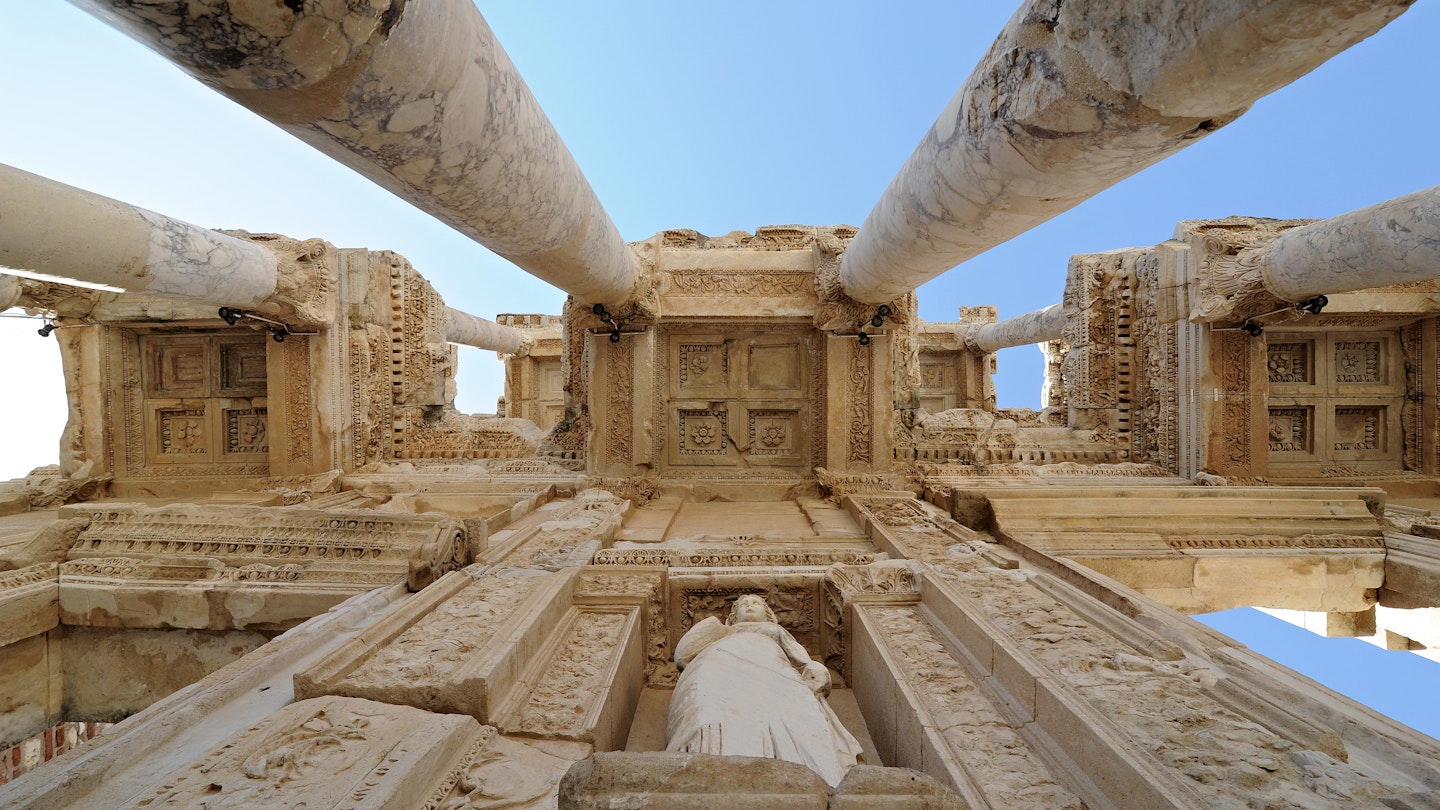
From classical cities scattered along the coast to archaeological sites that date back to the earliest periods of human history, Turkey’s fertile plains, high steppe, and rugged mountains have witnessed every stage on the human journey.
Even if you’re planning a beach break, don’t miss brushing up on some of this remarkable heritage while you’re here. These are the best ancient sites in Turkey.

Göbeklitepe
Visit this small hilltop pit of ringed megaliths to witness our earliest cultural beginnings. Göbeklitepe’s anthropomorphic T-pillars, decorated with carved vultures and foxes, were raised around 12,000 years ago in the pre-pottery Neolithic era when humans were still hunter-gatherers. Now recognized as the world’s earliest site of worship, Göbeklitepe’s discovery significantly challenged previous theories that religion followed the invention of agriculture and settled villages.
Göbekli Tepe is located 6.8 miles (11km) northeast of Şanlıurfa. Prior to your visit, consider exploring the Şanlıurfa Archaeology Museum for insights that enhance your understanding of this important site.

Hattuşa
The Hittites were Anatolia’s ancient superpower. In the 13th century BC, they faced Egypt’s Ramses II in the Battle of Kadesh, which resulted in the world’s first peace treaty. Today, the remains of Hattuşa, the Hittite capital, spread across a hillside surrounded by some of the grandest defensive ramparts ever constructed in the ancient world. For the best views, walk through the gabled tunnel of the postern gate, and ascend the monumental staircase cut into the massive manmade mound to the Sphinx Gate at the summit. From here, a panorama of the upper city’s ruined grand palaces and temples, now reduced to scattered stone outlines, unfolds.
Hattuşa is located in the village of Boğazkale, 125 miles (200km) east of Ankara. For independent travelers, visiting as a day excursion from Ankara is feasible. Additionally, tour companies in Cappadocia offer private day trips. For a less hurried experience, consider staying in Boğazkale to explore the nearby ancient sites of Yazılıkaya and Alacahöyük.

Troy
Wrapped in myth, the site now referred to as Troy consists of several settlements built atop one another, with origins ranging from the early Bronze Age (Troy I) to the Greco-Roman period (Troy VIII–IX). Its prominence peaked during the late Bronze Age (Troy VI) when this city-state gained power due to its control over the Dardanelles. Thanks to Homer’s Iliad, featuring the exploits of Achilles and company, Troy has become one of Turkey’s most renowned ancient highlights. However, walking through its jumbled layers of ruins can be underwhelming and confusing. A visit to the Troy Museum can greatly aid in comprehending the site.
Troy is located 18 miles (29km) southwest along the coast from Çanakkale. Many visitors arrive on a long day tour from Istanbul. Staying overnight in Çanakkale allows for a more leisurely experience.

Perge
Turkey’s Aegean and Mediterranean coastlines are filled with ruins of ancient city-state confederations like Lycia, Lydia, and Pisidia, which gained prominence during the Iron Age. According to local lore, Perge, located in ancient Pamphylia, was established by refugees fleeing the Trojan War, which initiated this city’s rise. The extensive ruins, predominantly from Perge’s later Hellenistic and Roman periods, showcase two nymphaeums (monuments devoted to nymphs), a bath complex, and an impressive Hellenistic gate demarcating a long colonnaded street. To capture picturesque photos, climb up to the acropolis and overlook the dramatic sweep of the street below.
Perge is situated 10 miles (16km) northeast of Antalya’s city center. You can take Antalya’s AntRay tram almost all the way to the ruins. Disembark at Aksu tram stop and walk 1.2 miles (2km) to the site’s entrance.

Patara
Many Aegean and Mediterranean city-states fell within the grasp of the powerful Persian and Hellenistic empires competing for control over Anatolia. Despite this, Lycia’s fierce independence allowed them a degree of autonomy over their affairs. Ancient Lycia stretched roughly from Dalyan to Antalya, and even after Romans established their claim, this unique confederation of 23 cities retained self-governance. Visit Patara, which is better known today for hosting Turkey’s longest beach, where the Lycian ruins of the ancient city extend down to the sand.
The ruins of Patara stretch for 0.9 miles (1.5km) between the beach and the small village of Gelemiş, located 10 miles (16km) northwest of Kalkan. You can easily reach Patara from either Kalkan or Kaş. Alternatively, Gelemiş itself has comfortable family-run guesthouses.

Ephesus
Most first-time visitors to Turkey include Ephesus on their itinerary. It stands as one of the world’s best-preserved classical-era cities. Although Ephesus has a history stretching much further back in time, it is the monuments and civic buildings erected when it served as the capital of Rome’s Asia Minor province that shopfront Ephesus as one of Turkey’s most significant tourist destinations. Stroll along the marble slabs of the Curetes Way, between the ornate, pillared façade of the Library of Celsus and the 1400-seat Odeon, past the brothel and fresco-decorated terraced houses to catch a glimpse of daily life in the ancient Mediterranean world.
Ephesus is an easy, flat 1.9-mile (3km) walk from the friendly small town of Selçuk, which serves as the best base for a visit.

Nemrut Dağı
While the coastal cities under Roman influence thrived, an obscure little kingdom emerged in the mountainous region of southeast Turkey, situated between Roman dominion and the Parthian Empire to the east. The Commagene Kingdom’s most celebrated ruler was Antiochus I, who, during his 32-year reign, managed to maintain amicable relations with larger neighboring powers on both sides. Not one to shy away from self-aggrandizement, Antiochus erected a monumental burial mound in his honor atop Nemrut Dağı (Mt. Nemrut) and dubbed it the “throne of the gods.” The statues and decapitated heads of Antiochus accompanied by other deities at the summit make this one of Turkey’s most enigmatic ancient locations.
Nemrut Dağı is located within Nemrut Dağı National Park. The summit is 33.5 miles (54km) northeast of Kahta. Independent travelers typically use Kahta, Adıyaman, or the village of Karadut on the mountain itself as their base.




